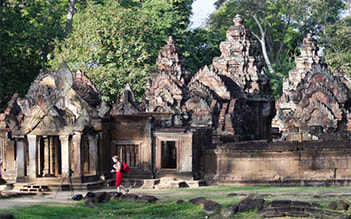Overview
Danang city is famous for its rich natural resources such as blue beaches, white sand banks, mountains and hills, fertile alluvial river systems. Not only that, Danang also owns quite many unique modern architectural works that are becoming the focus of domestic and foreign tourists. However, one of the places that attract tourists are the ancient relics and cultural heritage from thousands of ancient times, and Cham museum is a place like that.
A Marble Mountain and Cham Museum Haft day will take you to discover this spot.
Overview of Cham Museum
Champa Art Sculpture Museum, also known as Cham museum is located on 2/9 street Hai Chau district, Danang city. When tourists first entered this museum, they will be amazed by the unique Gothic architecture with a pointed arched roof style, plus a wide glass window system that helps sunlight shine every corner of the museum.
Gothic architecture strongly influenced by French architecture, combined with a wide space, and Champa flowers, gives each visitor a pleasant surprise. The entire building and the original architectural style of the museum are still preserved today, despite two important expansions in 1936 and 2002.

Cham museum
What to see in Cham Museum?
Cham museum was officially inaugurated in early 1919, is the museum displaying the largest scale Cham artifacts in the world, so it has become a prominent highlight of Danang tourism. The collection of sculptural works of the Champa kingdom from Ha Tinh to Binh Thuan and the Central Highlands provinces began in the late 19th century by archaeologists from Vien Dong Bac Co School of France cooperated with some Vietnamese who love archeology.
Currently Cham museum - one of the most tourist attractions in Danang, owns nearly 2000 large and small artifacts. In particular, the total number of art exhibits up to nearly 500 items and is divided according to geographical origin where they were discovered or excavated, including the rooms of Quang Tri, Tra Kieu, My Son and Dong Duong, Thap Mam - Binh Dinh, Quang Nam, Quang Ngai and an extended gallery.
With this way of dividing the geographical origin, the tourists who have experienced with cultural relics will easily recognize the imprint of the typical Cham architecture of each locality due to the cultural influence and lifestyle of each region of Vietnam in the past.

Cham museum
The exhibition space of Cham museum in Danang is really wide and surprised many tourists by mistaking it for its small appearance. With a total area of 6673 sq m, in which the 2000 sq m display area, in addition to the above geographic rooms, behind the museum is a new two-storey house built to display the antiquities still stored in warehouses and documents, pictures of Cham architecture and other cultures in Southeast Asia.
The main material of most of the existing sculptures at Cham museum is sandstone, earthenware and copper. Sandstone is most used in the period from the 7th century to the 15th century with extremely sophisticated and unique carving station patterns, expressing a supreme development of Cham sculpture art at that time.
After three artifacts are Tara Bodhisattva Statue, My Son E1 Temple and Tra Kieu Temple recognized as national treasures, the Cham museum attracts international visitors to Danang.
Through magazines and tourist information sites, many international visitors want to come to Vietnam, visit Da Nang to find Cham Museum. Because for them, the places that keep the vestiges of ancient civilization are not much and Danang's Cham Museum is such a rare tourist place in the world.




